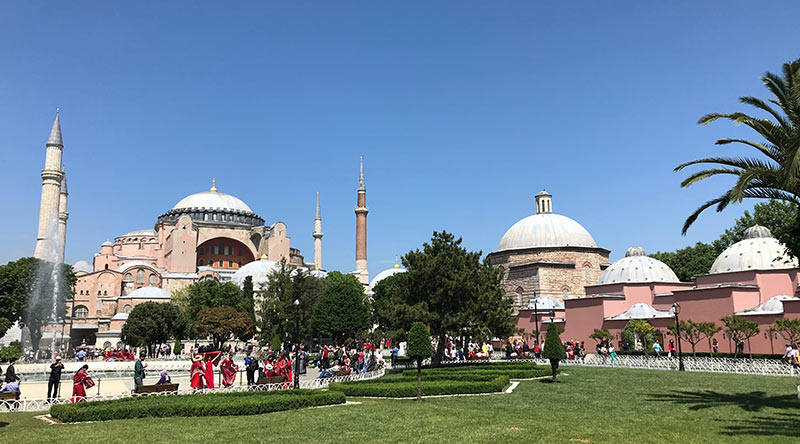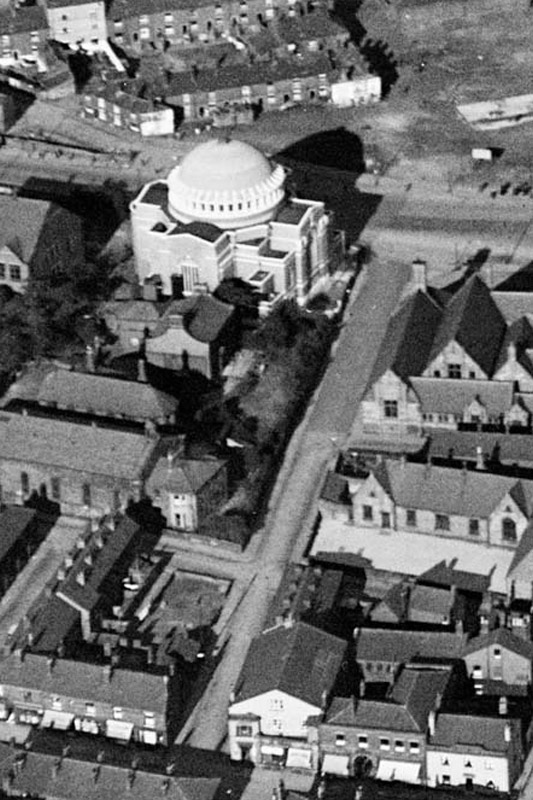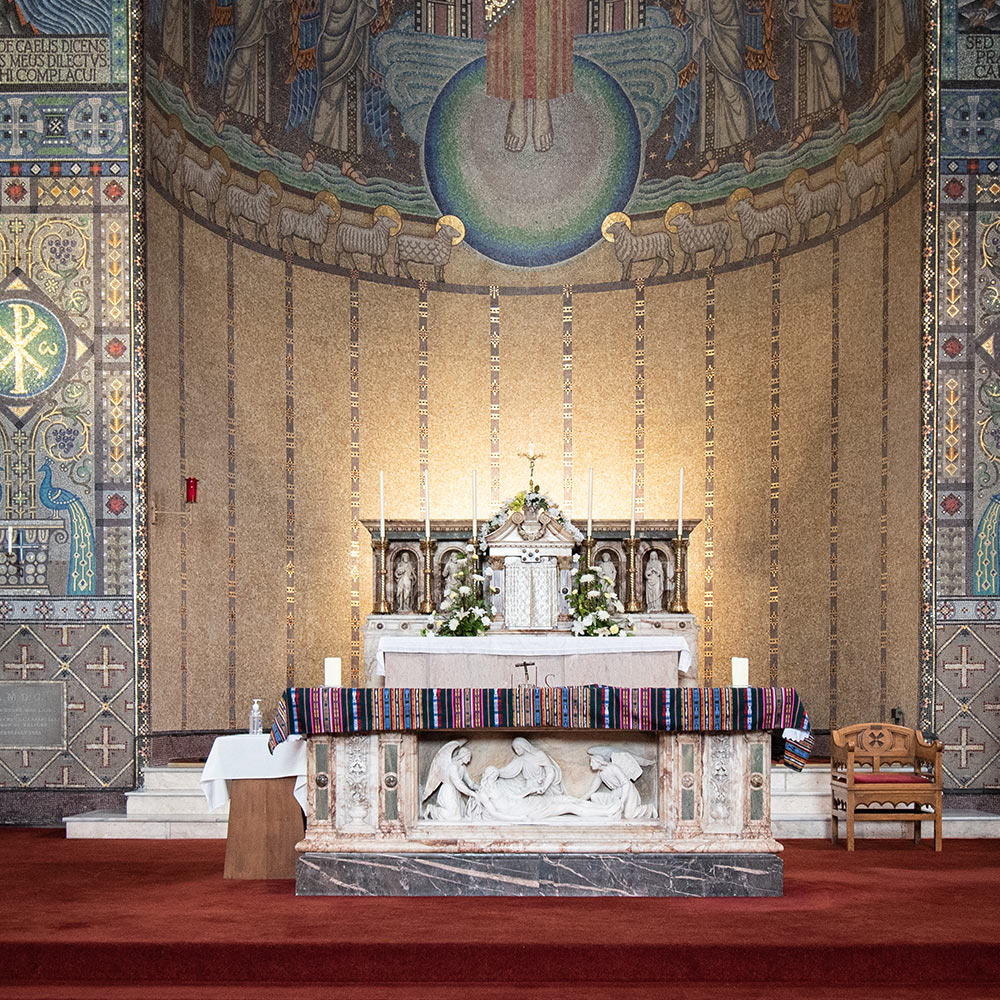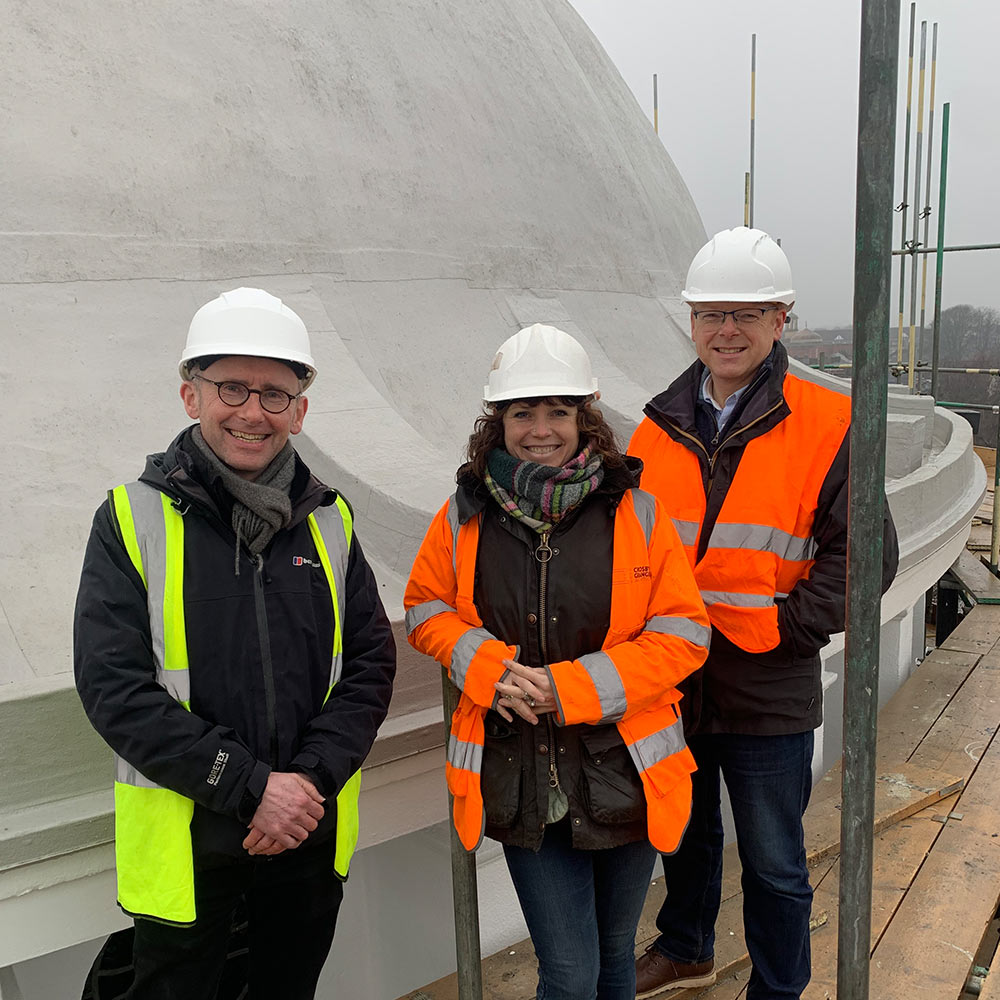The Heritage of St John the Baptist Church, Rochdale, is our inheritance – what the past has conceded to us, what we value in the present and what we choose to preserve for future generations.
Our heritage comprises:
the tangible – the church building, monuments, artefacts and archives;
the natural – woodland of trees, flowers, native wildlife, insects, plants, trees, birds and animals;
the human – the clergy and religious, the parishioners, including immigrants, refugees and asylum seekers; and
the intangible – languages, customs and traditions that people have brought to St John’s.
The parishioners of St John the Baptist Church recognise that their church has a distinguished heritage which is of interest to a wide range of visitors. As one of Rochdale’s finest buildings, visitors are welcome to step inside St John’s and discover why this Grade II* listed church has a special place in the history of Rochdale. It is our mission to preserve our heritage and to ensure more people engage with it.
- St John’s is situated at the transport gateway to the town
- it became a dramatic landmark in industrial Rochdale when it was built in the 1920’s
- it is a notable sixth-century Byzantine design based on what is now known as the Hagia Sophia Grand Mosque in Istanbul and the neo-Byzantine Westminster Cathedral, built in 1903
- it draws in visitors of differing faiths and those of no faith
- it has one of the finest and most dramatic mosaics in England covering the whole sanctuary
- it has welcomed newcomers to Rochdale throughout its existence, initially from Ireland and post-second world war from Ukraine, Poland, Italy and now from Africa and beyond.

Inspiration for St John’s
Hagia Sophia In Istanbul, Turkey, was open-end in 537 AD and was Canon Chipp’s inspiration for the design of St John’s. While the building is now a mosque and tourist attraction, it was originally built as a Greek Orthodox Church.


The growth of the Roman Catholic Church in Rochdale in the 19th Century
After the changes brought about through the provisions of the Catholic Relief Acts in the 1790’s, the small catholic community grew quickly. First with the establishment of St John the Baptist church on Belle Green (Ann Street) in the 1820’s and then with the founding of St Patrick’s on Yorkshire Street, Wardleworth, in the 1850’s.
St John’s had its first church constructed in 1829-30. St Patrick’s first church was constructed in 1861 on Watts Street, Rochdale. The early model of ministry for the two parishes was a lone priest who lived with a housekeeper. The Baptismal and marriage records for both churches show that from time to time a visiting or supply priest would stand in for the parish priest.
The changing role of the parish priest over the past two centuries can be related to the volume of sacramental demand which was being met on a weekly basis.
The long serving parish priests (at the time of rapid immigration brought about by the industrial revolution and famine in Ireland) John Dowling at St John’s and Michael Moriarty at St Patrick’s were baptising a hundred children per annum.
St John’s records examined
1822-1920: Baptisms 11,565 averaging 118 per annum
1832-1911: Marriages 1,763 averaging 22 per annum
1873-1917: Confirmations 2,757
Confirmations were administered on a cyclical basis by the Bishop every 6 years. There were approximately 350 per ceremony averaging about 80 per annum. All candidates had to be vetted by the Parish Priest.
St Patrick’s Records examined
1860-1919: Baptisms 8,117 averaging 138 per annum
1865-1922 Marriages 1,425 averaging 25 per annum
John Dowling remained a lone priest throughout his ministry. From 1841 to 1871 he is listed as head of household with a servant.
His successors Edward O,Neill and Henry Chipp had larger households to manage the increasing workload.
1881 Census
Edward O’Neill age 51 b1830 Ireland, Parish Priest
Thomas Walshe age 26 b1855 Ireland, Curate
Margaret Lawton 25 b1856 Manchester, Housekeeper
Sarah Smallman 21 b1860 Ireland, Housemaid
1901 Census
Henry Chipp 36 b1863 Dublin, Parish Priest
Wilfrid Cahalan 26 b1875, Manchester Curate
Mary Robinson 25 b1876, Manchester Domestic
Elisabeth Perry 15 b1886, Ramsbottom Domestic servant
The 1851 census provides some statistics about the growth of the catholic population in the Diocese of Salford.It shows there were 32 churches, 37 priests and 33,029 attended mass on 31st march 1851. The Irish community was 79,655 out of a population of 1,180,834.
William Turner the 1st Bishop of Salford had been a early priest in charge of the Rochdale mission.
The parish priest had financial priorities. It was important to the Catholic community to improve the standard of education of their parishioners. First they had to fund new school buildings and persuade parents to send their children to them. Building of new churches often took second place to the school fund. Schools became a constant theme in pastoral letters. Fr David Lannon in his M.Phil thesis analyses the success of the five principles of catholic education:
1. Catholic education had to be under catholic control
2. Education had to be based upon religion
3. Catholic education had to be made available to all catholic children as and when means permitted
4. Catholic education had to be efficient in its religious and secular content
5. The rights of parents to decide upon the education of their children had to be respected.
This philosophy had been established by William Turner who helped to establish the mission in Rochdale.
His successor Herbert Vaughan was not a fan of the 1870 Education Act which sought to broaden the school curriculum. Vaughan was of the mind that Education should be taught through religion. The diocese had been very successful in its provision of education of its rapidly growing catholic population. Vaughan wary of the increasing priority given to secular education by the school inspectorate established his own religious school inspectorate under the supervision of Fr Dunderdale to ensure that the five principles were being followed. School buildings were assessed and blacklisted as necessary for improvement. One interesting case study highlighted by Fr Lannon was the Category ‘A’ blacklisting of St John’s Infant school. Canon Chipp agreed that the buildings were bad but pleaded for a delay of three years because he had just built a new St John the Baptist Church at a cost of over £22,000.
The Education Board understanding the reality of the situation agreed they could do nothing at St John’s just yet.
The Roman Catholic community were being taken seriously
Peter Galvin, member Parish Team
During the course of building a bid for a grant from the National Lottery Heritage Fund, we have been assisted by a number of groups and individuals. They provided us with encouragement, support and practical help which helped us to formulate our plans.
A number of those who helped us to develop our ideas have gone on to become key partners offering a range of support. Below is a list of our key partners and the ways in which they have already helped the project or have committed to help in future.
Rochdale Town Hall project led by the Rochdale Development Agency (RDA)
The team has expressed an interest in using the spaces available in our church and at the town hall when it re-opens.
They have also suggested that we could work co-operatively across creative activities, design an Arts trail between the two buildings.
They would also like to develop “walking tours” of the local heritage sites
Crescent Radio
Crescent Radio is Rochdale’s only 24/7 broadcast radio station reaching the local Asian community. The station has helped us to reach an audience we would not normally easily access and has provided invaluable support in promoting the activities programme. We believe that this is a partnership which will has many benefits. It will help to strengthen ties in our local community,
The radio station has an ongoing heritage focus (and is a member of Heritage Compass), with engaging programmes exploring personal and music heritage and experiences of diaspora communities living in Rochdale. In partnership with the team at St John’s, Crescent Radio hopes to explore themes such as memory and identity in relation to the historic built environment, using stories emerging from St John’s as inspiration for new audio stories and content. The first podcast “A chip shop through time” has been recorded.
Initially Crescent Radio have worked with us and have provided studio facilities, they will help to recruit families or individuals from the community to provide interesting audio stories.
Action Together
Action Together CIO is the infrastructure organisation for the voluntary, community, faith and social enterprise (VCFSE) sector in Oldham, Rochdale, and Tameside.
St. John’s has been working with Action Together since May 2021, a membership which has helped us with,
- Support with recruiting and managing and training volunteer
- Provision of regular information about, news, funding and training
- Opportunities to promote the group and its services
- Ensuring our policies enable volunteers to fulfil their aims and aspirations
- Access to a number of small grants.
Action Together will help our project not only benefit volunteers individually but will also be a chance to work together with different faiths by establishing a programme for our volunteers that can be sustained indefinitely through local fundraising in the church and through access to funding.
Greater Manchester Fire service Museum
As close neighbours of the Church, and custodians of their own heritage building which houses the Greater Manchester Fire Service Museum, the Fire Station is in a unique position to be able to work together for the good of both projects and for Rochdale’s built heritage in general.
In terms of practical mutual assistance we have shared facilities (such as meeting rooms and car park space). We plan to work together on future events for the benefit of both organisations, our visitors and the public at large.
Other possible avenues of co-operation which could be explored include joint training events and the sharing of experiences and learning points from both sets of activity planning.
As we each move into our next phases of heritage management, there are likely to be numerous opportunities for sharing open day events, community engagement activities or promotion.
Historically, our two sites have a shared history in terms of architectural connection, period of construction and service to the local community. It is therefore a natural evolution to now turn that commonality into joint effort for the preservation of two of the Borough’s best-loved landmark buildings and the development of greater community involvement.
St Cuthbert’s R.C.High School
St. Cuthbert’s RC High School in Rochdale, serves nearly 1200 students and their families. The school has forged links with St.John’s which has a vision to create a long term partnership.
It was agreed that students from St. Cuthbert’s would engage in a Wellbeing Photography Course, facilitated by Robert Freeman. This course has been running successfully recently with a group of young students taking part. Taking inspiration from St. John’s heritage and the surrounding area as stimulus for the photography, the students will exhibit their work at the church and the school.
Photography will be used to help young people grow in skill and awareness of their local heritage environment while ‘Wellbeing’ is a key focus of this initiative.
The school has also held a heritage careers discussion, organised with the project team, with a range of pupils who were able to listen to and learn from heritage building specialist such as architects, a quantity surveyor, builders and conservationists. This was aimed at showing a range of employment opportunities within the heritage sector.
Deeplish Community Centre
Deeplish Community Centre although not one of our original key partners has very much become intrinsic to our future plans.
Deeplish have a cohort of youngsters on a leadership course who also benefitted from the heritage specialist team employed by St John’s, discussing not only the project itself but also their roles and responsibilities and their relationships to each other and the project. This again assisted their understanding of the possibilities of employment in the sector.
Working with Deeplish management the Heritage Officer is developing a ‘faith heritage walk’, again building links with the wider community and exposing them to local heritage.
Future craft events have been planned to be delivered by our volunteers at Deeplish Community Centre.
The partnerships mentioned are only a part of the work with the local community and its leaders to work towards opening up the church and making it a place of welcome. We will continue to work with our current partners and new ones to make St Johns a welcoming space for anyone to visit.
“This church [will] take its place among the notable churches of the country… [it has] given Rochdale a building not unworthy to rank with the great architectural achievements that already distinguish the town”. – Cardinal Bourne, Opening ceremony for St John’s in 1925
Key features of our artistic and architectural heritage
The building itself is a significant component of Rochdale’s treasured heritage. The church was built to accommodate the growing number of Roman Catholic people in the Rochdale area in at the beginning of the twentieth century. As the principal Catholic Church in the town, St John’s was designed to host up to 1200 people. At its heart, St John’s is a place of congregation and worship – somewhere for the community to come together, to meet and to pray. Through our restoration project and activity programmes, we want to honour the original purpose of St John’s as a working church serving those who wish to worship there and we are also committed to opening the building up to our diverse Rochdalian communities and visitors to the town.
St John’s is a modernist marvel. It was designed by Manchester architect Oswald Hill (who died as a World War One pilot in1917) and overseen by E Bower Norris. Building work started in 1923 and was completed in 1925. The church’s daring concrete design reinforced Rochdale’s reputation for striking civic structures and ecclesiastical buildings.
The current building replaced an earlier 1830s stone church, also named St John’s. Prior to its construction, catholic residents predominantly made up of migrant workers from Ireland, prayed in make-shift churches in the town’s woolen mills. For some in the community, the construction of the first St John’s represented a determination for religious equality and Rochdale’s tolerance of diversity. The unusual ‘in-the-round’ design of our current church also creates a large circular space for people to congregate.
St John’s is an iconic Rochdale landmark building with a dome that can be seen for miles around. The present church was the inspiration of the Reverend Henry Chipp who was parish priest from1897 until 1936. He wanted it designed in Byzantine style based on the church of Santa Sophia in Istanbul. Plans were prepared before World War One (1914-18) when the cost of the building including campanile or bell tower (which was not built) was an estimated £12,800. The architects were Mr E Bower Norris and Mr Oswald Hill.

Bishop Casartelli laid the foundation stone to the new church on 28 July 1923. The building was completed in 1925 at a cost of £21,000. St John’s was built in the style of a Greek cross with the four transepts forming the arms of the cross. The concrete dome and the barrel vaults are one single slab of concrete, only five inches thick at the dome and 95 feet high. While the dome demonstrated the early use of concrete, the outer face of the building is in brick and is the work of local builders R & T Haworth who also built the nearby Fire station Museum as well as many other Rochdale buildings.
The altar, pulpit, organ, baptismal font, altar rails and pews were transferred from the old church. The pulpit was later removed and remodelled to construct the lectern, the organ was replaced by an electric organ and the baptismal font was moved from the back of the church to its present position at the front.
The Second Vatican Council, which concluded in 1965, resulted in many changes to the way the Catholic Church functioned. At St John’s the alar rail was removed, a new altar was placed near the front of the sanctuary so the priest could face the people and the Mass was celebrated in English rather than Latin.
It was reasonable to expect that the changes that were made to the liturgy and the configuration of the church would help parishioners to engage more fully in the life of the church. In reality society was changing, faith practice was declining and the number of practising Catholics attending St John’s was far below the numbers the church was built to accommodate. In the 1990s, in response to these changed conditions and to foster community cohesion, a community room and kitchen were built in the north transept while parish accommodation, a piety shop and a sacristy were constructed in the south transept. The glass-fronted narthex at the back of the church was yet another adaptation from the original design.
Bishop Casartelli laid the foundation stone to the new church on 28 July 1923.




“The Oppenheimer mosaic at St John’s is of national and international significance. It is one of the best surviving examples of Eric Newton’s work” – Gary Bricknell, Mosaic Artist and Conservator
The interior of St John’s is characterised by long curved lines and unadorned smooth walls. At the heart of the church, in the sanctuary, are the opulent Oppenheimer mosaics, designed and coordinated by the artist Eric Newton. These awe-inspiring floor-to-ceiling decorations are widely recognised as one of the finest examples of modernist art and craft in the country with international significance making it of artistic, historic and architectural interest.
Designed by Eric Newton, the floor-to-ceiling mosaic covers a vast apsed sanctuary space. The high-quality tiles were sourced from Venice, where Newton was trained, as well as other glass and tesserae from artisans in France. Newton’s mosaic covers an area of over 315 square metres and depict scenes from the bible, including an unusual depiction of the devil (almost unique in Catholic churches), inspired by 19th century artist William Blake. The central motif is a large image of Christ, immersed in gold that glistens and catches the light as you move through the church. Eric Newton’s scheme and the central image were all inspired by Byzantine designs and traditions found in Turkey, which also influenced the development of Islamic architecture.

“It’s a multi-cultural town where people live and work closely together, particularly in the area where the church is located”. – Local Resident
Throughout Its existence, visitors to St John’s have been singularly impressed by the splendor of the artwork and for some visitors the rich tapestry of individual pieces also emerged as an inspirational symbol for Rochdale’s mosaic of multicultural communities.
“St John’s mosaics can represent the different people and communities living in Rochdale” – Asylum Seeker
The sanctuary mosaic has the potential to connect with a wide range of audiences. Some who see the mosaic want to understand the visual language and symbolic nature of the artwork. For others there is a particular interest in how the artist designed the mosaic and how skilled craftsmen made the mosaic. It has even been suggested that the mosaic of many colours that work together is an appropriate metaphor for Rochdale which could be viewed as a town made up of a mosaic of many different cultural communities!
‘Roman Catholic church. Original design pre-1917 by Oswald Hill (d.1917), executed in 1923-25 by Ernest Bower Norris of Manchester architects’ practice Hill, Sandy and Norris. Mosaic scheme of 1932-33 by Eric Newton. Ferro-concrete dome and barrel vaults, red brick with artificial stone dressings. Early Christian Byzantine style.’
The official entry explains that its Grade II* listing is due to its artistic interest – the Oppenheimer mosaic – and its architectural interest – the Byzantine style with a large dome in the manner of Hagia Sophia.
If you have got this far using the new parish website, it would be great if you could spare a couple of minutes to complete our short survey. Your responses will help us to improve the way we present our parish and our heritage. The survey is completely anonymous and the results will only be used for statistical purposes.
Keep up-to-date with all the happenings at St John the Baptist Church, Rochdale. Sign up to our newsletters and be the first to hear about upcoming events, news and opportunities to support the Church.
